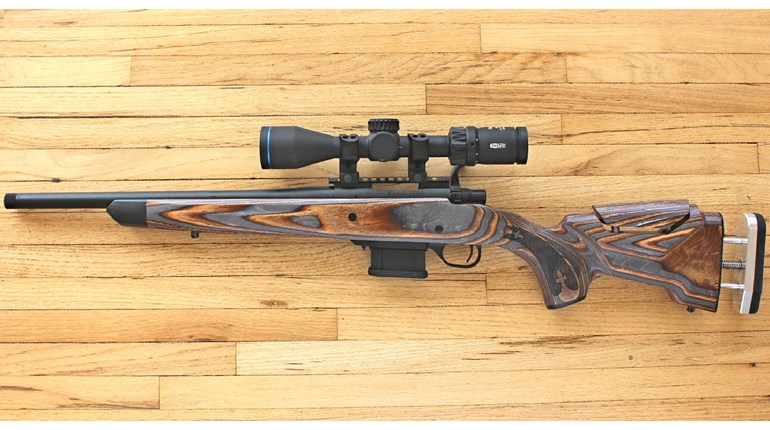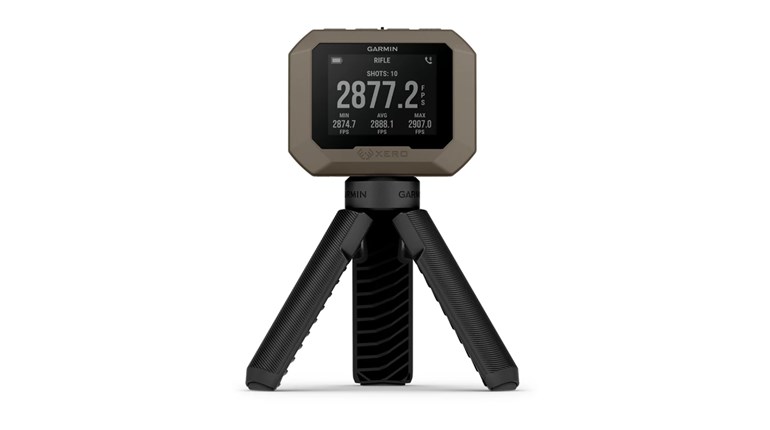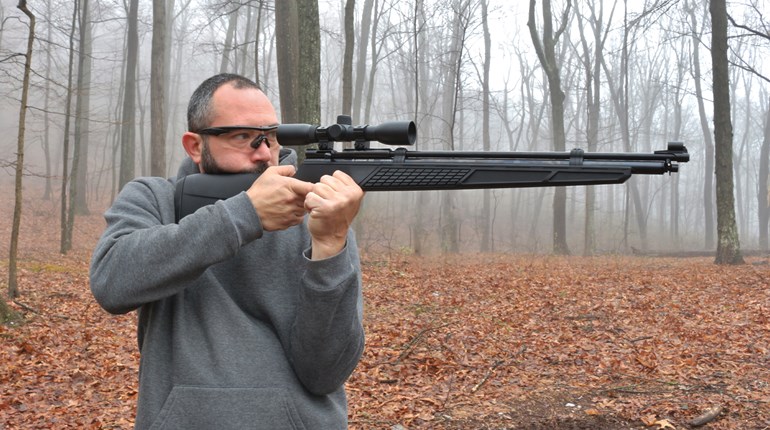
Laser rangefinders are great. They provide accurate distance-to-target information with the touch of a button, beyond 1,000 yards, often showing up to the party taking up less space and weight than a deck of cards. That performance-to-size ratio comes at a price though, which is optical performance. Physics has to rear its ugly head, and the small objective lens on these pocket-sized rangefinders isn’t ideal for an observation optical instrument. “So what? I’m not using my rangefinder as a monocular or spotting scope,” you might say. True. But, if possible, it would be great to combine your laser rangefinder with a good quality binocular for better optical performance and versatility. That’s where Leupold’s BX-4 Range HD TBR/W rangefinding binocular comes in. It is a premium binocular with an integrated laser rangefinder at the high end of the performance envelope.
The BX-4 Range HD TBR/W rangefinding binocular is Leupold’s first real entry into this product category. It is a familiar 10X42 binocular configuration that is great for hunting, providing enough magnification to be useful in open country, but not so zoomed-in you can’t use it in the woods or other close confines. It does not have some of the bells and whistles you might find on other rangefinding binos such as Bluetooth connectivity or advanced ballistic software for customized cartridge data. But as is often said, you don’t get something for nothing. With the BX-4 Range HD TBR/W rangefinding binocular you do get Leupold’s high-performance optics, durability, waterproof performance and accurate and consistent rangefinding technology and capability.

Right out of the box the BX-4 Range HD TBR/W comes with everything you need to strap in and start glassing and ranging. Included in the package are a functional binocular harness, objective lens covers, eyecup covers, a data card for setting up the rangefinder and, of course, instructions that were promptly discarded, then quickly recovered from the trash when I couldn’t figure out how to put in the included battery. If you haven’t used a pouch-type binocular harness before, you are going to want to start doing so. It makes a binocular much more comfortable to carry and much easier to access while simultaneously keeping it more secure and tucked to your chest. This binocular is not light, so don’t even think about just a neck strap, you’ll regret it.
Disregarding the rangefinder for a moment, the BX-4 Range HD TBR/W is what you would expect from a premium binocular. The waterproof body is rubber-armor coated in an attractive gray color, has a center focus wheel, a right eye diopter adjustment, a tripod adapter attachment point, telescoping eyecups for use with or without eyeglasses, strap attachment points and covers for the lenses. The ergonomics are great, with intuitive placement and positive texture on the focus wheel. The “HD” nomenclature and performance is because of multiple coatings on the lenses and prisms. These coatings enhance abrasion resistance and light transmission. The result is good low light performance, durability, image quality and detail.
The BX-4 Range HD TBR/W has all the right optical features, but the whole point of this bino is the rangefinder. This iteration is a powerful system that can accurately provide distance to target data out to 2,600 yards on reflective targets. It will give an accurate range on game animals beyond practical shooting distances, out to an advertised 1,100 yards.
The heart of the Leupold rangefinding technology is the TBR (True Ballistic Range) system. This takes the angle of the shot into account to provide the actual distance for correction, not the line-of-sight distance. Just getting the line-of-sight reading is an option in the menu. Their technology includes 25 ballistic groups to match most cartridge and handload setups. The user selects the group that most closely matches the velocity and ballistic data of their desired cartridge. When a target is lased, the red OLED read-out provides the ballistic solution for the range to target which can be displayed in MILS, MOA or centimeters for those in countries that haven’t landed on the moon. The wind hold is also displayed. The shooter can then easily make the needed adjustment for the shot with their scope’s elevation dial, reticle aiming or basic hold-over. Ballistic data is provided out to 800 yards. Beyond that, only the range-to-target data is displayed.

Menu options for the rangefinding system include the aiming point type, display brightness, distance measured in yards or meters, the aforementioned output options, and whether the user wants the line-of-sight distance, the true ballistic range, or trig (horizontal distance). The power and range activation button can also be selected left or right to accommodate left-handed shooters.
Scouting, blacktail hunting and a recent mule deer hunt provided opportunities to see if the the BX-4 Range HD TBR/W binocular lived up to its corporate hype. In short, it really did. Image quality was clear, color was great and there were no obvious issues with glare, distortion, etc. Focusing the bino for each eye was quick with clear results, never having to reset it. Low light performance was quite good. I haven’t had it wet for days on end yet, but some dunk tests involving working the eyecups and focus and have not revealed any leaks.
The rangefinder works great. It picks up targets quite well. I verified the TBR ballistic groups against two factory loads I shoot often, the Hornady 6.5 Creedmoor, 140-grain ELD-Match and .308 Win. 178-grain ELD-Match, as well as a couple of handloads. Using 600 yards as the metric for comparison, the data was within just a few inches of what was shown on my Kestrel. At that range the variance is inconsequential, with most reticles covering up that much of the target at that distance. As a bonus, the BX-4 Range HD TBR/W binocular makes you feel like Luke Skywalker when he was scanning the landscape for R2 and Sand People.
So, why do you want the BX-4 Range HD TBR/W? Because it eliminates a piece of gear, provides much better optical performance than the pocket-sized rangefinders and can save critical time when trying to make a shot. With a rangefinding binocular, you simply spot your target, range while in view, then switch to your rifle and get busy, without the need to switch to a separate rangefinder. Saving this additional step can mean the difference between getting the shot or losing sight of your target. An entire hunting season can come down to this one encounter. These will stack the odds in your favor.
No one is perfect, and neither is the BX-4 Range HD TBR/W binocular. It doesn’t give the shooter the option of customized ballistic data, and that would be nice for a bino with a MSRP of $1,599.99. That said, the simplicity can be appreciated. The 25 groups available cover the gamut of the most common hunting cartridges and then some. Look up the right group, set it and go shoot. The binocular is also heavy. Not “these should come with a set of wheels” kind of heavy, but its 2.4-pound weight is noticeable. The provided harness does mitigate the effects of this though.
Overall, the BX-4 Range HD TBR/W binocular is a great choice for the shooter that is keeping shots to 800 yards or less and doesn’t want to spend a lot of time setting up customized loads and data, but wants great rangefinding performance, practical and accurate ballistic corrections, solid optical performance and rugged durability. Frankly, I didn’t want to like this binocular. At first, the lack of customizable ballistics was underwhelming. But the more I used it and experimented with the ballistic groups and my cartridges and handloads, the more I appreciated the simplicity and practicality of the TBR system. I’m looking forward to using the BX-4 Range the rest of the deer-hunting season.
Technical Specifications
• Type: laser-rangefinding binocular
• Magnification: 10X
• Objective Lens Diameter: 42mm
• Measurement Range: 12-2,600 yds. (reflective); 12-1,100 yds. (deer)
• Eye Relief: 17mm
• Field of View @ 1,000 Yards: 334 ft.
• Coatings: fully multi-coated, Leupold’s Elite Optical System
• Construction: aluminum frame, rubber-armor coated; HD objective lenses; waterproof, fog-proof, shockproof
• Length: 5.9"
• Weight: 39 ozs.
• Accessories: Pro Guide Binocular Harness, lens caps, cleaning cloth, CR2 battery
• MSRP: $1,599.99; leupold.com





































